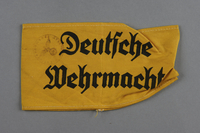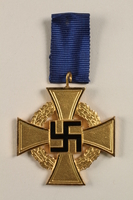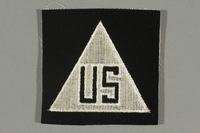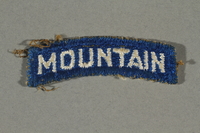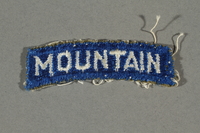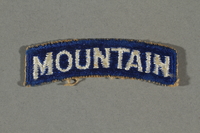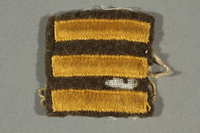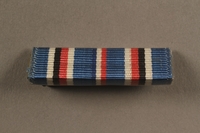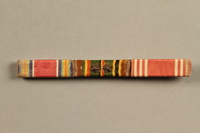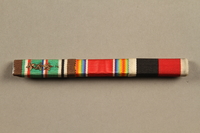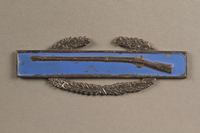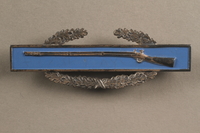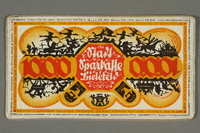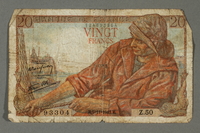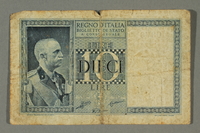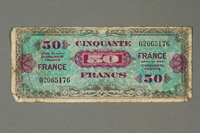Overview
- Description
- The Gerald Schwab papers document Schwab’s work for the International Military Tribunal following World War II; research for his books The Day the Holocaust Began: The Odyssey of Herschel Grynszpan and OSS Agents in Hitler's Heartland: Destination Innsbruck; his efforts to receive restitutions for Holocaust-era losses; biographical, genealogical, and photographic materials documenting Schwab and his family; and audiovisual and electronic records documenting Schwab’s interests in Holocaust-era topics.
International Military Tribunal records include trial documents, photographs and illustrations, personal records, and correspondence documenting Schwab’s work at the Nuremberg trials. Trial documents include material used in conjunction with the Nuremburg trials such as witness lists, a document stating the mental competency of Rudolf Hess, and summaries of the days in court. Photographs and illustrations consists of photographs, ranging from the Palace of Justice and the courtroom itself to the Doctor’s Trial (United States of America vs. Karl Brandt, et. al.) and court officials. Photographs include small and large prints of the defendants and the prosecutors and a photo album with larger prints of the International Military Tribunal in action, with captions explaining the various scenes. Also included are caricature sketches of the defendants by German newspaper caricaturist, Peis. Personal documents include correspondence created by Gerald Schwab while working for the International Military Tribunal, passes to the trials, a list of the medals and pins he donated to the United States Holocaust Memorial Museum, orders, and related items. Correspondence includes Schwab’s personal letters describing his Nuremberg work to relatives and friends, subsequent efforts to collect documents related to the trials, and a 45th anniversary reunion of Nuremberg staff.
Records related to The Day the Holocaust Began: The Odyssey of Herschel Grynszpan include Schwab’s correspondence, publishing records, research files, and writings created during his research into Grynszpan’s assassination of Ernst vom Rath and the publication of his book on the same topic. Correspondence includes letters exchanged with researchers and individuals interested in the Grynszpan case as well as with research institutions holding relevant records. Publishing records document the process of the book’s publication and include correspondence with publishing firms, legal records, announcements and reviews, endorsements for the book, and correspondence with production companies about the possibility of making a film based on the book. Research files include manuscripts about Herschel Grynszpan by Alain Cuenot and Friedrich Grimm, articles and clippings about Grynszpan, reproductions of original source material, and some of Schwab’s notes and lists of sources.
Occupation Greenup records document Schwab’s research into Operation Greenup, a mission that parachuted three German-speaking spies into the area around Innsbruck to investigate Nazi fortifications and track their movements. Records include drafts of articles and chapters, a letter from Fred Mayer, notes, photographic materials (photographs, negatives, and copy prints), postcards of Ambergerhütte and Oberperfuss, printed materials (originals and photocopies), research materials, information about Schwab’s 2006 Rotteck Gymnasium visit, and tourist information and maps.
Restitution paperwork consists of correspondence, forms, financial records, and legal records documenting the Schwab family’s efforts to receive compensation for money and property confiscated during the Holocaust. Claims relate to personal property and valuables, immigration costs, taxes, pensions, and family businesses registered in Germany, Switzerland, and France.
Biographical and genealogical materials include identification papers; birth, marriage, and death certificates; immigration and travel records; military service records; employment records; family trees and genealogical research documenting the Schwab family. Loose photographs, copy prints, and negatives depict Gerald Schwab and his family during his childhood in Breisach, Germany, his military career, his postwar work in Europe, his wife and children, and his diplomatic career. Two small photograph albums also depict Gerald Schwab and his family during his childhood in Breisach. Audiovisual and electronic records include audiocassettes, floppy disks, CDs, and DVDs documenting interviews, exhibits, commemorative events, related to Herschel Grynszpan, Kristallnacht, the Holocaust, the Nuremberg trials, and Gerald Schwab’s writings. - Date
-
inclusive:
1885-2012
- Credit Line
- United States Holocaust Memorial Museum Collection, Gift of Gerald Schwab
United States Holocaust Memorial Museum Collection, Gift of Susan Schwab and Teresa Marshall - Collection Creator
- Gerald Schwab
- Biography
-
Gerald (Gerd) Abraham Schwab (1925-2014) was born in Freiburg im Breisgau, Germany to David and Paula Kleefeld Schwab (d. 1995). His father owned an international plumbing supply company with a branch in Basel, Switzerland. Gerald had a sister, Margot, born in 1920. The family was somewhat observant Jews who attended synagogue on holidays, and Gerald was Bar Mitzvahed in 1938. He attended the local primary school in Freiburg.
In January 1933, Hitler was appointed Chancellor, and there was a Nazi-led boycott of Jewish businesses. The Schwab family left Germany for Switzerland, but the Swiss authorities would not permit them to settle in Basel near their business. The family moved to St. Louis, a town just over the French border from Basel. For the next two years, David commuted to the office daily. In 1935, the French implemented a measure stipulating that refugees could no longer reside within 100 kilometers (60 miles) of the border with Germany. Not wanting to abandon the Basel business, Gerald’s parents decided to move back to Germany. They settled Lörrach, which was just over the German border from Basel, and continued to run the company. Sometime in 1937 or 1938, David’s permit to travel was revoked by the Nazi government. He began the process of liquidating the business and applying for American visas. The Schwabs received an affidavit of support from a relative in the US and were put on a waiting list of would-be immigrants.
After the Kristallnacht pogrom of November 9-10, 1938 and Gerald’s subsequent dismissal from school, the Schwabs focused all their energy on emigration. Gerald’s mother heard about a Swiss organization willing to sponsor refugee children to live in Switzerland. She submitted an application, and Gerald became one of only 300 Jewish children to be selected for the program. Gerald’s sister was not living with the family by this time. Shortly before the Schwabs moved back to Germany, she went to live at a French boarding school in Remiermont. A few years later she was able to immigrate to the U.S. Gerald left for Switzerland in March or April of 1939. He stayed first on a small family farm in Moenchaltdorf and later moved to Huetten ob Waedenswil, where he lived in the home of a florist, who was probably an adherent of the Jehovah’s Witnesses. In the spring of 1940, Gerald received word from his parents that their visas had come through and were ready to be picked up in Stuttgart. Gerald rejoined his parents in Germany, and the three secured their visas on May 10, 1940, the day Germany invaded Belgium and Holland. Barred from leaving Germany through the Low Countries, Gerald’s father applied for a transit visa at the Italian consulate. A well placed gift secured the visas, and they proceeded to Genoa. There they boarded the SS Washington bound for New York. After a period of transition, the Schwabs purchased a poultry farm in Cranberry, N.J.
In May 1944, Gerald was drafted into the U.S. Army. He joined the 10th Mountain Division and was sent to Italy in October of that year. At the end of the war he was transferred to an intelligence unit and assigned to the U.S. Detailed Interrogation Center (USDIC). At this facility, where high level German captives were being interrogated prior to being sent to trial, Gerald worked as a translator and interpreter. He remained at the USDIC until May 1946 when he was discharged from the army. Gerald immediately went to work for the International Military Tribunal (IMT) in Nuremberg. There he served as a translator and interpreter for the commission hearing evidence on the seven Nazi organizations that were under indictment by the IMT. In particular, he was involved in hearings about the German High Command and General Staff of the Wehrmacht. Gerald remained in Nuremberg until the day the IMT defendants were executed. He then moved to Berlin where he worked for the U.S. Chief of Consul responsible for trying the Subsequent Nuremberg Proceedings. Assigned the position of junior research analyst, Gerald sifted through the collection of Nazi files stored at Tempelhof airport and made abstracts of relevant documents for specific cases. His research focused on material for the Justice Trial. In May 1947 Gerald decided to return to the U.S. to pursue his higher education. He studied political science at the University of Chicago and Stanford before launching a career in the American foreign service. He was married on December 25, 1949 to Ingeborg (now Joan) Nussbaum, a German Jew from Berlin who had escaped from Germany on a Kindertransport to Great Britain shortly before the war. Both of her parents perished in the Holocaust.
Gerald Schwab’s book The Day the Holocaust Began: The Odyssey of Herschel Grynszpan was published in 1990 and his book OSS Agents in Hitler's Heartland: Destination Innsbruck was published in 1996.
Physical Details
- Genre/Form
- Photographs.
- Extent
-
10 boxes
3 oversize boxes
21 oversize folders
- System of Arrangement
- The Gerald Schwab papers are arranged as thirteen series:
Series 1: International Military Tribunal, Trial documents, 1934-1947
Series 2: International Military Tribunal, Photographs and illustrations, 1946-1947
Series 3: International Military Tribunal, Personal documents, 1935-1947
Series 4: International Military Tribunal, Correspondence, 1946-1995
Series 5: Herschel Grynszpan book, Correspondence, 1950-2009
Series 6: Herschel Grynszpan book, Publishing and production records, 1982-1998
Series 7: Herschel Grynszpan book, Research files, approximately 1966-1994
Series 8: Herschel Grynszpan book, Writings, 1951-approximately 1980s
Series 9: Operation Greenup records, 1945-2013
Series 10: Restitution paperwork, 1924-2001
Series 11: Biographical and genealogical materials, 1885-2011
Series 12: Photographs, approximately 1916-1971
Series 13: Audiovisual and electronic records, 1994-2012
Rights & Restrictions
- Conditions on Access
- There are no known restrictions on access to this material.
- Conditions on Use
- Material(s) in this collection may be protected by copyright and/or related rights. You do not require further permission from the Museum to use this material. The user is solely responsible for making a determination as to if and how the material may be used.
Keywords & Subjects
- Topical Term
- Nuremberg War Crime Trials, Nuremberg, Germany, 1946-1949. War crime trials--Germany--Nuremberg. Crimes against humanity, German. Kristallnacht, 1938. Jewish refugees--France. Espionage, American--Germany--History--20th century. Anti-Nazi movement--Germany--History. World War, 1939-1945--Participation, Jewish. Holocaust, Jewish (1939-1945)--Reparations. Jews--Germany--Breisach am Rhein. Jewish refugees--United States.
- Geographic Name
- Nuremberg (Germany) Breisach am Rhein (Germany)
- Personal Name
- Schwab, Gerald, 1925-2014. Goering, Hermann, 1893-1946. Hess, Rudolf, 1894-1987. Ribbentrop, Joachim von, 1893-1946. Keitel, Wilhelm, 1882-1946. Kaltenbrunner, Ernst. Rosenberg, Alfred, 1893-1946. Frank, Hans, 1900-1946. Frick, Wilhelm, 1877-1946. Streicher, Julius, 1885-1946. Funk, Walther, 1890-1960. Schacht, Hjalmar Horace Greeley, 1877-1970. Raeder, Erich, 1876-1960. Schirach, Baldur von, 1907-1974. Sauckel, Fritz, 1894-1946. Jodl, Alfred, 1890-1946. Papen, Franz von, 1879-1969. Seyss-Inquart, Arthur, 1892-1946. Speer, Albert, 1905-1981. Von Neurath, Konstantin, Freiherr, 1873-1956. Fritzsche, Hans, 1900-1953. Lawrence, Geoffrey, Baron Oaksey, 1880-1971. Biddle, Francis, 1886-1968. Parker, John Johnston, 1885-1958. Donnedieu de Vabres, H. (Henri), 1880-1952. Nikitchenko, Iona Timofeevich. Falco, Robert. Birkett, Norman Birkett, Baron, 1883-1962. Volchkov, Alexander Fedorovich, 1902-1978. Jackson, Robert H., 1892-1954. Kranzbühler, Otto, 1907-2004. Shawcross, Hartley Shawcross, Baron, 1902-2003. Rudenko, R. A. (Roman Andreevich) Champetier de Ribes, Auguste, 1882-1947. Grynszpan, Herschel Feibel, 1921-approximately 1943. Rath, Ernst Vom, 1909-1938--Assassination. Mayer, Frederick, 1921-2016.
Administrative Notes
- Holder of Originals
-
United States Holocaust Memorial Museum
- Legal Status
- Permanent Collection
- Provenance
- Gerald Schwab and his daughters Susan Schwab and Teresa Marshall donated the Gerald Schwab papers to the United States Holocaust Memorial Museum in 2002, 2015, and 2016. The accession formerly cataloged as 2015.513.1 has been incorporated into this collection
- Funding Note
- The cataloging of this collection has been supported by a grant from the Conference on Jewish Material Claims Against Germany.
- Record last modified:
- 2023-08-28 07:49:27
- This page:
- https://collections.ushmm.org/search/catalog/irn538671
Additional Resources
Download & Licensing
- In Copyright - Use Permitted
- Terms of Use
- This record is not digitized and cannot be downloaded online.
In-Person Research
- Not Available for Research: Out for Digitization
- Plan a Research Visit
-
Request in Shapell Center Reading Room
Bowie, MD
Contact Us
Also in Gerald Schwab collection
The collection consists of artifacts and documents relating to the experiences of Gerald Schwab
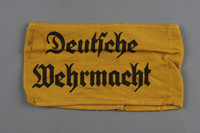
Armband
Object
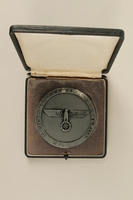
Medal
Object
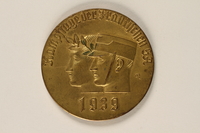
Medal
Object
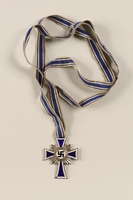
Cross of Honor of the German Mother medal, 2nd Class Order, Silver Cross
Object
The Mother's Cross was instituted by the Nazi Party in 1938. It was first awarded in 1939 to some 3 million mothers as a propaganda measure to promote National Socialist population policy.
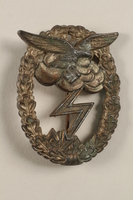
Pin
Object
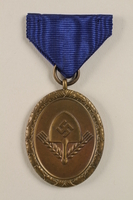
German Worker's medal
Object
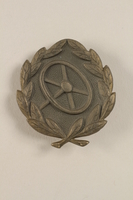
Pin
Object
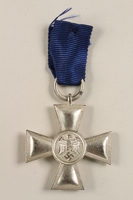
Medal
Object
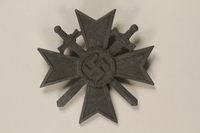
Pin
Object
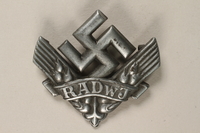
Pin
Object
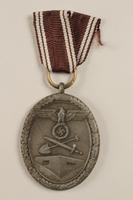
Westwall Defense medal
Object

Iron Cross Pin
Object

Pin
Object
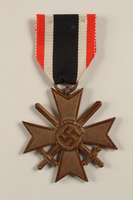
War Service Cross Medal
Object
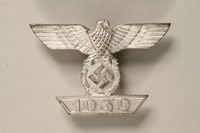
Pin
Object
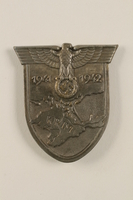
Crimean campaign pin
Object
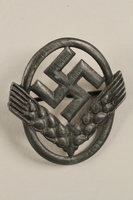
RAD hat pin
Object
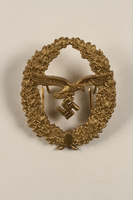
Shooting badge pin
Object
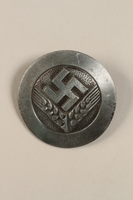
RAD pin
Object
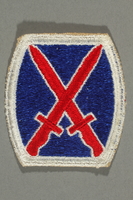
Badge
Object
Fabric badge depicting crossed red swords against a blue background, with a white border.

Badge
Object
Fabric badge depicting crossed red swords against a blue background, with a white border.
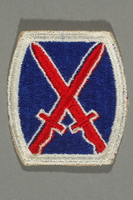
Badge
Object
Fabric badge depicting crossed red swords against a blue background, with a white border.
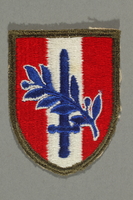
Badge
Object
Shield-shaped fabric patch with red and white stripes and an olive branch crossed with a sword.
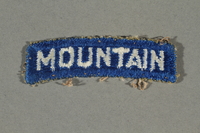
10th Mountain Division tab worn above the divison's uniform patch
Object
Rectangular, blue fabric tab for the 10th Mountain Division, which would be worn above the division's patch on a uniform.

Pin
Object
Oval shaped painted metal pin with crossed swords and a military helmet, ringed by a laurel wreath.
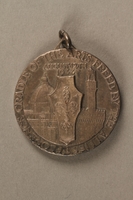
Liberation of Florence medal
Object
Round metal medal commemorating the liberation of Florence on August 12, 1944. The words "Florence/Cradle of the Arts/Freed by the Allies" along with images of famous Florentine buildings on one side and the words "Democracy/Prosperity/Freedom" and three flags, including British and American flags, on the other.
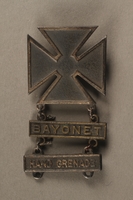
Medal
Object
Cross shaped pin-backed medal with hanging bars with words "Bayonet" and "Hand Grenade."
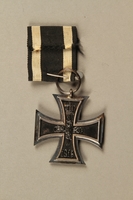
Iron Cross medal with box
Object
WWI Iron Cross medal with blue and white striped ribbon and accompanying box.
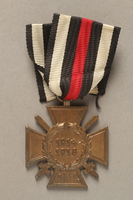
WWI Iron Cross medal with ribbon
Object
Iron Cross medal with red, white and blue striped ribbon attached to loop on medal.
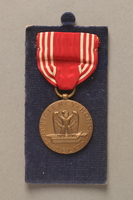
American Army Good Conduct medal
Object
Round medal with eagle perched on a sword and a closed book. Around the outside are the words, “EFFICIENCY, HONOR, FIDELITY.” The reverse of the medal has a five pointed star just above center with a blank scroll. Above the star are the words, “FOR GOOD” and below the scroll is the word, “CONDUCT.” A laurel wreath surrounds the design. A red and white striped ribbon is attached to the medal, which is pinned to a cardboard/blue fabric backing.
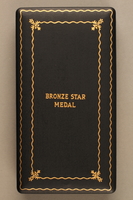
Bronze Star medal with lapel pin, certificate and box
Object
Bronze Star medal with the name Gerald Schwab inscribed on the reverse, along with a lapel pin, certificate from the War Department, and the accompanying box.
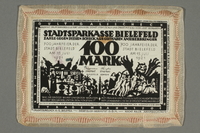
Linen notgeld
Object
100 Mark German emergency currency, or "notgeld" printed on linen. The currency is dated 15 July 1921.
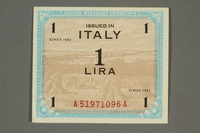
1 Lira Allied Military Currency
Object
1 Lira Allied Military Currency issued in Italy in 1943. Serial number A 51971096 A.
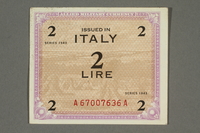
2 Lira Allied Military Currency
Object
2 Lira Allied Military Currency issued in Italy in 1943. Serial number A 67007636 A.
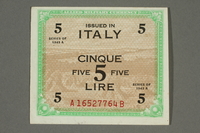
5 Lira Allied Military Currency
Object
5 Lira Allied Military Currency issued in Italy in 1943. Serial number A 16527764 B.
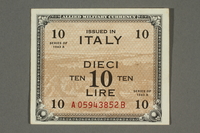
10 Lira Allied Military Currency
Object
10 Lira Allied Military Currency issued in Italy in 1943. Serial number A 05943852 B.
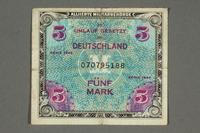
5 Mark Allierte Militarbehorde currency
Object
5 Mark Allierte Militarbehorde currency, series 1944. Serial number 070795188.
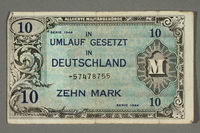
10 Mark Allierte Militarbehorde currency
Object
10 Mark Allierte Militarbehorde currency, series 1944. Serial number 57478755.
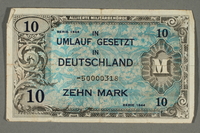
10 Mark Allierte Militarbehorde currency
Object
10 Mark Allierte Militarbehorde currency, series 1944. Serial number 50000318.
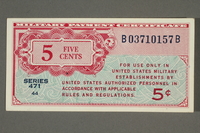
American 5 Cent military payment certificate
Object
American 5 Cent military payment certificate, serial number B 03710157 B.
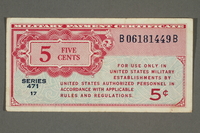
American 5 Cent military payment certificate, serial number B 06181449 B.
Object
American 5 Cent military payment certificate, serial number B 06181449 B.
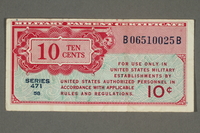
American 10 Cent military payment certificate
Object
American 10 Cent military payment certificate, serial number B 06510025 B.
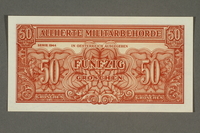
50 Groschen Allierte Militarbehorde currency
Object
50 Groschen Allierte Militarbehorde currency, series 1944.
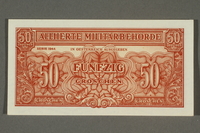
50 Groschen Allierte Militarbehorde currency
Object
50 Groschen Allierte Militarbehorde currency, series 1944.
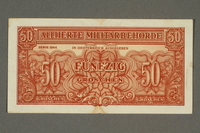
50 Groschen Allierte Militarbehorde currency
Object
50 Groschen Allierte Militarbehorde currency, series 1944.
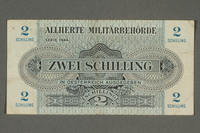
2 Schilling Austrian Allierte Militarbehorde currency
Object
2 Schilling Austrian Allierte Militarbehorde currency, series 1944.
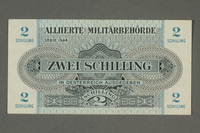
2 Schilling Austrian Allierte Militarbehorde currency
Object
2 Schilling Austrian Allierte Militarbehorde currency, series 1944.
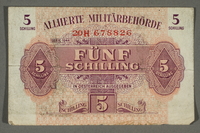
5 Schilling Austrian Allierte Militarbehorde currency
Object
5 Schilling Austrian Allierte Militarbehorde currency, series 1944. Serial number 20H 678826.
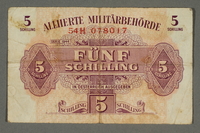
5 Schilling Austrian Allierte Militarbehorde currency
Object
5 Schilling Austrian Allierte Militarbehorde currency, series 1944. Serial number 54H 078017.
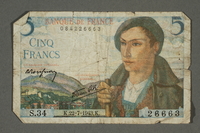
French 5 Franc scrip
Object
French 5 Franc scrip. Issued by the Bank of France. Serial number 084226663.
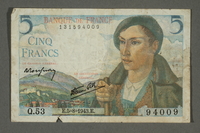
French 5 Franc scrip
Object
French 5 Franc scrip. Issued by the Bank of France. Serial number 131594009.
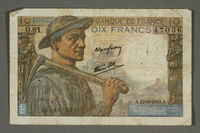
French 10 Franc scrip
Object
French 10 Franc scrip. Issued by the Bank of France. Serial number 201347036.
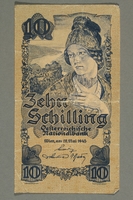
10 schilling Austrian scrip
Object
10 schilling scrip issued by the Oesterreichische Nationalbank in Vienna, 29 May 1945.
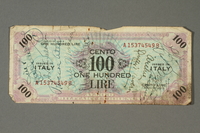
100 lire scrip
Object
100 lire scrip, series 1943, issued in Italy as Allied Military Currency. The scrip has several signatures on the front.
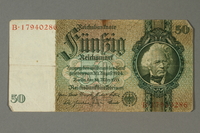
50 Reichsmark scrip
Object
German 50 Reichsmark scrip, serial number B 17940286, issued in Berlin in March 1933.
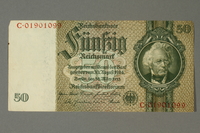
50 Reichsmark scrip
Object
German 50 Reichsmark scrip, serial number C 01901099, issued in Berlin in March 1933.
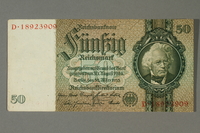
50 Reichsmark scrip
Object
German 50 Reichsmark scrip, serial number D 18923909, issued in Berlin in March 1933.
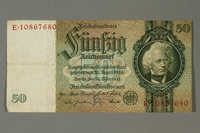
50 Reichsmark scrip
Object
German 50 Reichsmark scrip, serial number E 1867680, issued in Berlin in March 1933.
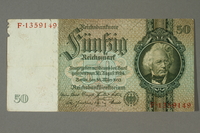
50 Reichsmark scrip
Object
German 50 Reichsmark scrip, serial number F 1359149, issued in Berlin in March 1933.
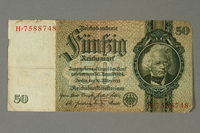
50 Reichsmark scrip
Object
German 50 Reichsmark scrip, serial number H 7588748, issued in Berlin in March 1933.
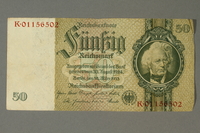
50 Reichsmark scrip
Object
German 50 Reichsmark scrip, serial number K 01156502, issued in Berlin in March 1933.
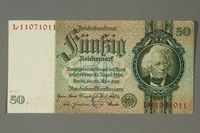
50 Reichsmark scrip
Object
German 50 Reichsmark scrip, serial number L 11071011, issued in Berlin in March 1933.
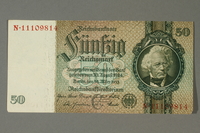
50 Reichsmark scrip
Object
German 50 Reichsmark scrip, serial number N 11109814, issued in Berlin in March 1933.
Box
Object

